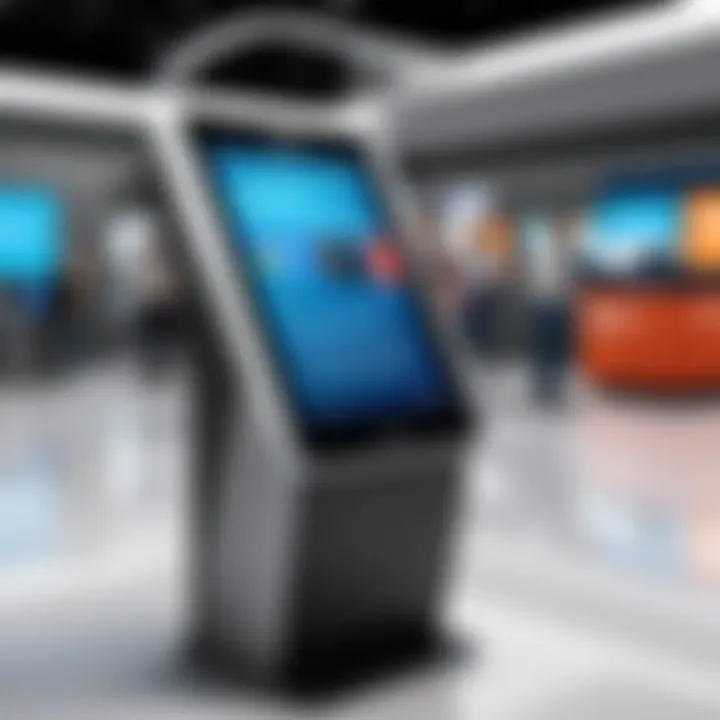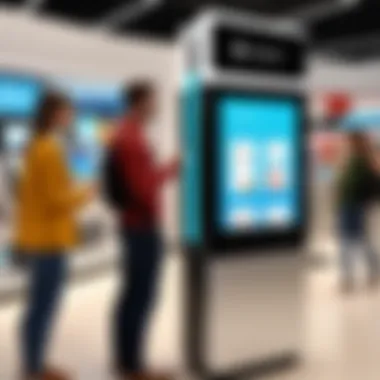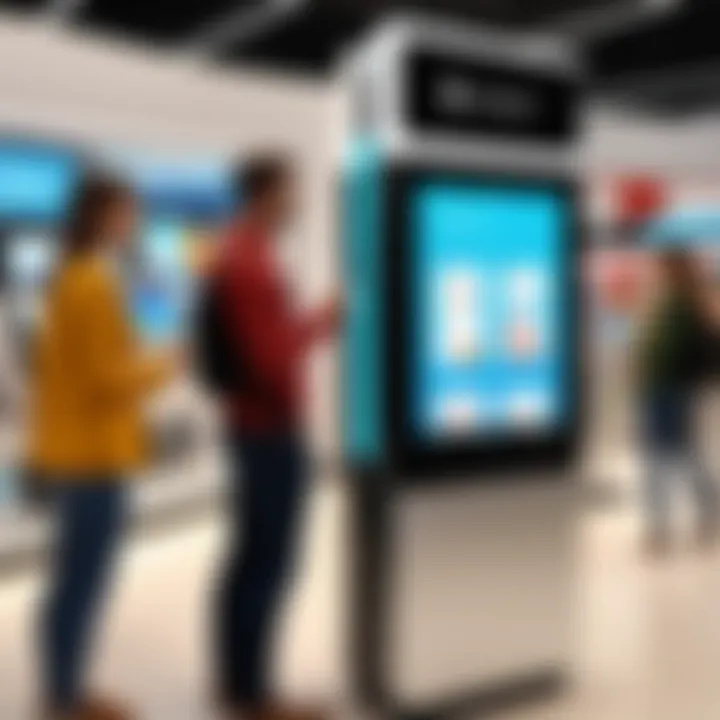The Impact of Sling Kiosks on Business Efficiency


Intro
Sling kiosks have emerged as a vital component in today's business landscape. As technology evolves, these kiosks offer unique solutions for enhancing customer experiences and streamlining business operations. The increasing need for efficiency and innovative engagement strategies has pushed many businesses to adopt these tools. This article will explore the various facets of sling kiosks: their functionality, advantages, integration, challenges, and future trends.
The following sections will provide a thorough overview of how sling kiosks operate and their significance in different environments. Businesses can leverage this knowledge to improve customer interactions and efficiency in operations.
Software Category Overview
Definition and Importance
Sling kiosks are self-service terminals that allow customers to perform a variety of tasks without the need for direct human interaction. These include ordering products, checking in for appointments, or accessing information. The importance of sling kiosks lies in their ability to enhance customer experience by providing fast and efficient service. They help in reducing wait times and increasing customer satisfaction. For businesses, this translates into improved operational efficiency and potential cost savings.
Key Characteristics
Sling kiosks possess several key characteristics that make them appealing for modern business applications:
- Self-Service Capability: Customers can independently execute transactions.
- User-Friendly Interface: Intuitive designs enhance usability for a wide range of customers.
- Customizable Solutions: Businesses can tailor functionalities to meet specific needs.
- Data Collection: These systems can gather and analyze customer data, helping businesses understand consumer behavior.
Comparative Analysis of Top Software Options
Feature Comparison
When evaluating the top software options for sling kiosks, it is critical to examine their features. Some notable options include:
- NCR Self-Service Kiosks: Known for robust payment processing and integration with various payment methods.
- Diebold Nixdorf: Offers customizable solutions focusing on enhancing customer interaction and operational efficiency.
- SlimKiosk: Provides a lightweight, portable option that is perfect for smaller businesses or events.
Pricing Models
Understanding the pricing models is essential for decision-makers. Common models include:
- Subscription-Based: Regular payments for software use, often including updates and support.
- One-Time Purchase: A single payment for ownership, often with additional costs for maintenance.
- Licensing Agreements: Businesses pay for the right to use the software in conjunction with hardware.
"The investment in sling kiosks can provide significant returns, especially for high-traffic environments where efficiency is paramount."
Prologue to Sling Kiosks
Sling kiosks represent a significant advancement in the way businesses interact with customers. These self-service machines are designed to facilitate a variety of transactions, enhancing the efficiency of service delivery. Understanding the role of sling kiosks in the current business environment is crucial for decision-makers, particularly in sectors that rely heavily on customer engagement. By streamlining processes such as ordering, payment processing, and information dissemination, these kiosks can significantly improve operational workflows.
The advantages of deploying sling kiosks are manifold. They provide businesses with the ability to reduce labor costs by minimizing the need for extensive staff involvement in routine transactions. Furthermore, these kiosks offer an interactive user experience, allowing customers to engage at their own pace. As technology advances, the role of sling kiosks becomes ever more prominent, with businesses increasingly adopting this solution to stay competitive in a fast-paced market.
Investment in such technologies also aligns with the growing demand for contactless services, especially in today's climate that prioritizes health and safety. This section will explore the definition, origins, and evolution of sling kiosks, paving the way for a deeper understanding of their strategic importance for modern businesses.
Definition and Overview
Sling kiosks can be defined as self-service terminals that allow customers to perform various tasks independently. These tasks may include placing orders, making payments, and seeking information. Unlike traditional kiosks, sling kiosks are characterized by advanced technology, such as touchscreens and integrated payment systems. These features are designed to enhance the user's experience by making each interaction seamless and efficient.
The overview of sling kiosks highlights their versatility. They are applicable in numerous sectors, including retail, healthcare, and transportation. Each application leverages the core functions of the kiosk, allowing businesses to customize experiences according to their specific needs. Moreover, as consumers continue to embrace digital solutions, the need for innovative service channels like sling kiosks becomes increasingly essential.
Origins and Evolution
The concept of kiosks is not new; however, the evolution of sling kiosks represents a noteworthy shift in functionality and technology. Kiosks have existed for decades, primarily serving as information terminals. The early designs were often simplistic, limited in interaction, and largely ineffective in handling complex transactions.
With the advent of digital technology, particularly in the late 20th century, kiosks began to evolve. The introduction of touchscreen interfaces marked a turning point, allowing for more intuitive user experiences. This evolution did not stop there; the integration of payment processing capabilities transformed kiosks into comprehensive service solutions. Sling kiosks emerged as a response to growing demands for efficient, user-friendly service options.
Today, they embody advanced features such as remote management and analytics capabilities, allowing businesses to monitor performance and optimize user experiences. The continuous innovation in hardware and software associated with sling kiosks ensures that they remain relevant in an ever-evolving business landscape. Understanding this evolution is key to appreciating their current role and potential in modern business environments.
Key Features of Sling Kiosks
Understanding the key features of sling kiosks is pivotal for recognizing their transformative impact on modern business environments. These features not only enhance customer experience but also streamline operational efficiencies. By examining these aspects, stakeholders can appreciate how these kiosks integrate into various sectors, driving innovation and engagement.
Interactive User Interface
The interactive user interface of sling kiosks plays a crucial role in user engagement. It provides an intuitive design that allows customers to navigate easily through options, improving overall user experience.
Features may include touch screens, voice recognition, and visual prompts that make interactions seamless. An appealing interface can reduce the time spent on a transaction, thus enhancing customer satisfaction.
Moreover, an effective UI fosters customer loyalty by facilitating self-service options. Customers enjoy the autonomy of completing transactions at their own pace, which can also lead to increased spending. In an age where consumers desire quick and efficient service, the significance of an interactive user interface cannot be overstated.
Payment Processing Capabilities
Payment processing capabilities are among the most critical features of sling kiosks. Businesses must provide diverse payment options to cater to a broad customer base. Sling kiosks can accept credit and debit cards, mobile payments, and sometimes even cryptocurrency. This variety is not just a convenience; it is essential in a competitive market.
The security of transactions is another key consideration. Sling kiosks must adhere to stringent data protection standards to secure customers' financial information. Consumers are becoming increasingly concerned about their data safety. Hence, providing secure payment processing can enhance trust and encourage repeat visits. The kiosk’s ability to process payments rapidly also reduces wait times, contributing to a smoother customer experience.
Remote Management and Monitoring
Remote management and monitoring are indispensable features for optimizing operations. Business owners can access real-time data about kiosks from any location. This includes information about transaction status, user interactions, and potential technical issues.
Utilizing cloud-based solutions allows for instant updates to software, ensuring the kiosks run smoothly without requiring physical intervention. Furthermore, analytics obtained from remote monitoring can provide valuable insights into customer behavior. Decision-makers can leverage this data to refine marketing strategies, manage inventory levels, and understand peak usage times.
In summary, the ability to manage kiosks remotely facilitates improved decision-making, enhances operational efficiency, and ultimately leads to better customer service.


Benefits of Implementing Sling Kiosks
Implementing sling kiosks in a business environment provides several benefits that can significantly enhance operations. These kiosks serve not only as customer engagement tools but also as vital components that streamline business processes. Understanding these advantages is essential for decision-makers looking to improve their service delivery and operational efficiency.
Enhancing Customer Experience
Sling kiosks are designed to improve customer interaction at various touchpoints. Customers can enjoy self-service options which allow them to complete transactions at their own pace. This autonomy reduces the feeling of waiting in long lines, often leading to greater customer satisfaction.
The intuitive interfaces of these kiosks also accommodate various user preferences. Simplicity in design ensures that users can navigate easily, whether they are tech-savvy or not. Additionally, customization features can cater to unique preferences, making every interaction more personal. Enhanced customer experience often leads to positive reviews and repeat business, crucial for companies looking to expand their market reach.
Operational Efficiency Boost
Operationally, sling kiosks can yield significant efficiency improvements. By automating routine tasks like order taking and payments, businesses can decrease the workload on staff. This allows employees to focus on more complex issues that require human intervention, effectively reallocating human resources.
Moreover, using sling kiosks can minimize human error common in manual processes. Accurate transactions reduce mismanagement of inventory and billing errors. Features like quick service enable faster customer processing, which can lead to a marked increase in throughput during peak hours. As a result, businesses can generate additional revenue without the need to hire more staff.
Data Collection and Analytics
Sling kiosks provide valuable insights through the collection of data during customer interactions. All transactions, preferences, and feedback are captured efficiently. This information can then be analyzed to understand customer behaviors and trends more clearly.
Businesses can use these insights for better inventory management, targeted marketing strategies, and improved service delivery. For example, data may reveal the most popular products or services, enabling better stock management. Furthermore, understanding peak usage times helps in staff scheduling. Collecting data not only aids in immediate decisions but also in long-term strategic planning.
"Data-driven decisions lead to better outcomes. Sling kiosks gather essential information benefitting both customers and business operations."
The effective implementation of sling kiosks aids in enhancing customer experience, boosting operational efficiency, and enabling data-driven decision-making. These elements combined create a compelling case for adopting this technology in modern business environments.
Applications in Various Industries
Sling kiosks have rapidly gained recognition for their unique applications across multiple sectors. Their versatility and adaptiveness make them invaluable tools in today’s business landscape. As organizations look for ways to enhance operations, these kiosks offer tailored solutions that align with specific industry needs. This section will explore how sling kiosks are employed in three main sectors: retail, healthcare, and transportation. Each industry reveals distinct benefits and considerations that come with their implementation.
Retail Sector Usage
In the retail sector, sling kiosks contribute significantly to customer engagement and sales processes. They serve as interactive platforms that allow customers to browse products, check prices, and even make purchases without needing assistance from staff. This functionality addresses several pain points. For instance, during peak hours, kiosks can alleviate congestion at checkout by providing an alternative purchasing method.
A few key advantages of implementing sling kiosks in retail are:
- Improved Customer Experience: Shoppers can find information quickly, reducing wait times.
- Sales Growth: With direct access to online inventory, customers can complete purchases that might have been lost due to stock unavailability on the floor.
- Cost Savings: Retailers can optimize labor by shifting repetitive tasks to kiosks, allowing team members to focus on more complex customer engagements.
Healthcare Facility Implementation
In healthcare settings, sling kiosks play a vital role in streamlining patient interactions. They simplify processes such as patient registration and appointment scheduling. Visitors can check in electronically, update personal information, and manage appointments without needing to wait in line. This not only improves patient satisfaction but also increases operational efficiency.
Important elements for successful kiosk application in healthcare include:
- Data Security: Protecting sensitive patient information is paramount. Kiosks must comply with regulations like the Health Insurance Portability and Accountability Act (HIPAA).
- Accessibility: Ensuring that the kiosks are user-friendly is critical. They should be designed to accommodate various needs, including for those with disabilities.
- Integration with Existing Systems: Effective communication with electronic health record (EHR) systems is essential for accurate and timely data handling.
Transportation and Public Services
The transportation sector has seen a shift towards digitization, with sling kiosks facilitating streamlined services in places such as airports, train stations, and bus terminals. These kiosks enable travelers to check in, print boarding passes, or purchase tickets without waiting in line, which enhances the overall travel experience.
Key benefits observed in this context are:
- Increased Efficiency: Reducing the reliance on staff for basic functions allows operations to run smoother, especially during busy travel periods.
- User Empowerment: Passengers have control over their travel arrangements, allowing for flexibility in managing itineraries.
- Real-Time Updates: Kiosks can provide real-time information about delays or changes, improving communication between service providers and travelers.
Implementing sling kiosks in the transportation sector encourages self-service, fostering greater traveler autonomy and satisfaction.
The applications of sling kiosks in various industries underline their potential to transform business operations. By enhancing customer engagement, improving efficiencies, and ensuring compliance, organizations in retail, healthcare, and transportation can leverage this technology to meet modern demands successfully.
Challenges in Deployment
The implementation of sling kiosks within various business environments is not without its complexities. Understanding these challenges is crucial for decision-makers and IT professionals as they navigate the integration of these systems. Properly addressing these hurdles ensures that the full potential of sling kiosks is realized.
Technical Integration Issues
Integrating sling kiosks into existing business operations often presents technical challenges. Businesses need to ensure that the kiosk systems work seamlessly with current infrastructure. This involves connecting to Point of Sale systems, customer databases, and inventory management software. Improper integration can lead to data inconsistencies and operational disruptions.
Moreover, selecting the right hardware and software platforms is vital. Not all kiosks are compatible with every business model. Therefore, enterprises must evaluate their existing technology and select kiosks that will complement their current systems. This necessitates a thorough assessment to prevent costly redeployments or system failures after installation.
User Acceptance Concerns
Another significant challenge involves user acceptance. Employees and customers may be hesitant to adopt new technology due to fears of complexity or replacement of traditional jobs. For employees, there might be concerns regarding job security. Educational initiatives and training programs can help alleviate these worries by demonstrating how kiosks enhance rather than replace roles.
From the customer perspective, it is important to design kiosks with user-friendly interfaces. Resistance from customers may stem from unfamiliarity or a dislike for digital interactions. Therefore, conducting user testing during the design phase is crucial. This helps in gathering feedback that can inform adjustments to enhance user experience, ensuring that customers are comfortable and willing to engage with the kiosks.
Maintenance and Support Requirements
Deploying sling kiosks requires a robust maintenance and support plan. As technology evolves, so do the needs for system updates and troubleshooting. Companies must ensure that they have the resources available to address any technical problems that arise post-deployment.
Regular maintenance checks are essential to keep the kiosks functioning efficiently. This not only minimizes downtime but also enhances user satisfaction. Businesses should develop a comprehensive maintenance schedule and assign responsibilities to specific team members.


Implementing an efficient support system can aid in resolving user issues quickly, thereby reducing frustration and preserving the brand’s reputation.
Furthermore, vendors often provide warranties and support plans. Understanding these offerings can help businesses make informed decisions about long-term agreements. Managing these relationships can prove beneficial in keeping kiosks operational and effective.
Future Trends in Sling Kiosk Technology
The landscape of sling kiosk technology is rapidly evolving. Businesses are increasingly recognizing the need to adapt to consumer expectations and technological advancements. This section focuses on the future trends that are shaping the sphere of sling kiosks. Understanding these trends allows companies to stay competitive while enhancing their customer engagement strategies.
Artificial Intelligence Integration
Artificial Intelligence (AI) is becoming crucial in the functionality of sling kiosks. By leveraging AI, these kiosks can offer improved customer interactions, personalized recommendations, and faster service. For instance, AI can analyze consumer behaviors and preferences, generating insights that help in tailoring experiences.
Moreover, AI algorithms help in predicting peak hours and service demands, optimizing kiosk availability accordingly. This not only improves user satisfaction but also boosts sales. The integration of AI can lead to smart kiosks that learn from customer interactions, adjusting their offerings based on real-time data. The ongoing advancements in natural language processing can also enhance communication between kiosks and users.
Customization and Personalization Advances
Customization and personalization remain key attractions of modern kiosks. As consumers seek unique experiences, businesses must offer tailored solutions. Future sling kiosks will likely incorporate advanced customization capabilities, allowing users to modify their interactions based on personal preferences. This could include selecting language options, layouts, or even themes.
Furthermore, the data collected can be used to create targeted marketing campaigns. For example, a kiosk in a retail setting might analyze purchase history to suggest relevant products. Such personalization can significantly enhance the customer experience, making them feel valued and understood.
Sustainability Considerations
Sustainability is becoming a priority across industries, including kiosk deployment. Companies are now evaluating the environmental impact of their technologies. Future sling kiosks will likely adopt more sustainable materials and energy-efficient designs.
For instance, the use of solar panels for kiosk operation could become more popular. Additionally, manufacturers may focus on recyclable materials and minimalistic designs to reduce waste. By emphasizing sustainability, businesses not only comply with regulations but also appeal to a growing segment of environmentally conscious consumers.
"Incorporating sustainability measures in technology is no longer optional. It is a necessity for modern businesses aiming for longevity."
This combined focus on AI integration, customization, and sustainability will push sling kiosks into a new era, where they significantly contribute to operational efficiency and customer satisfaction. In acknowledging these trends, businesses position themselves advantageously within a competitive market.
Comparative Analysis with Traditional Kiosks
The importance of the comparative analysis between sling kiosks and traditional kiosks cannot be overstated. Businesses often face the challenge of deciding on the right technology to implement for enhancing customer engagement and operational efficiency. By understanding the differences in cost-effectiveness, usability, and maintenance requirements, decision-makers can make informed choices that align with their organizational goals and customer expectations.
Cost-Effectiveness Evaluation
When evaluating cost-effectiveness, sling kiosks tend to show advantages over traditional kiosks. Traditional kiosks often require significant upfront capital investment. This includes not only the hardware but also ongoing software licenses and frequently, on-site IT support. On the other hand, sling kiosks often utilize cloud-based solutions, which can minimize initial costs. Cloud services are typically subscription-based, spreading the cost over time and allowing companies to scale resources as necessary.
Moreover, sling kiosks can integrate with existing systems without the need for substantial overhaul. Businesses can benefit from reduced operational costs due to automation and improved efficiency in handling transactions. This saves both time and labor, contributing positively to the overall financial outlook of an organization.
Usability Differences
Usability is another critical factor in the comparative analysis. Traditional kiosks may suffer from outdated interfaces and limited functionalities, leading to user frustration. Users may struggle to navigate clunky systems, which can deter engagement and diminish customer satisfaction. Sling kiosks, however, focus heavily on interactive user interfaces, often employing touch screens, voice recognition, and personalized user experiences.
These innovations enhance user engagement, making it simpler for customers to accomplish their desired tasks. Sling kiosks can be configured to tailor the interface according to individual preferences. This level of customization leads to a more intuitive experience, essential in maintaining today’s tech-savvy consumers.
Maintenance and Operational Costs
Maintenance is typically more challenging with traditional kiosks. Physical components may fail, requiring costly repairs or replacements. Additionally, traditional systems often necessitate dedicated IT staff to handle software updates and troubleshooting. In contrast, sling kiosks, with their cloud-based management, allow for remote monitoring and updates. This greatly reduces physical maintenance needs and allows organizations to allocate their resources more efficiently.
Operational costs also tend to be lower with sling kiosks due to their high reliability. The advanced technology used here results in fewer breakdowns and errors, enhancing overall uptime. This is crucial for any business aiming to provide seamless and uninterrupted customer services.
"By examining the comparative elements of sling kiosks and traditional kiosks, businesses can strategically select solutions that enhance operational capabilities and delight customers."
In summary, the comparative analysis provides critical insights that guide organizations in choosing the right kiosk technology. With the various factors at play, understanding the nuances can lead to better investment decisions and a more productive business environment.
Case Studies on Successful Implementations
Examining case studies on the successful implementation of sling kiosks offers crucial insight into their practical applications and benefits within various sectors. These cases reveal real-world examples of how businesses harness the technology to meet modern demands. They validate the arguments regarding the efficiency, customer engagement, and operational improvements previously discussed in this article. Such case studies also serve as benchmarks for other organizations considering integrating sling kiosks into their operations, enabling them to make informed decisions.
Retail Outlets
In the retail sector, businesses such as Walmart and Tesco have implemented sling kiosks to streamline customer purchasing processes. These kiosks provide a self-service option, allowing customers to check out purchases without needing a cashier. This enhances customer experience by reducing wait times during busy hours.
Other advantages include:
- Improved inventory management through real-time data updates.
- Greather customer engagement, as shoppers can scan and learn about products via the kiosk's interface.
Customer feedback reveals that many prefer this technology as it offers them more control over their shopping experience. The success of these kiosks in retail shows how modern customers value efficiency and autonomy.
Health Institutions
Health institutions like hospitals and clinics have adopted sling kiosks to simplify patient check-in processes. For example, Mount Sinai Health System in New York implemented kiosks allowing patients to register for appointments quickly.
This has led to several significant benefits:
- Reduction of paperwork and administrative tasks for staff, improving overall efficiency.
- Enhanced patient satisfaction as visitors can complete registration and check-in with ease.
Kiosks also facilitate data collection, allowing health institutions to gather information that supports operational decisions and helps monitor patient flow. When people see that hospitals are modernizing their processes, they often feel more confident about their care.


Event Management and Coordination
In the event management sector, sling kiosks play a vital role in guest registration and ticketing. A relevant case is the use of kiosks at music festivals like Coachella. These kiosks allow attendees to easily check in, redeem tickets, and obtain wristbands.
Key aspects of their success include:
- Highly efficient processing capabilities, leading to shorter lines and improved attendee experience.
- Integrated payment solutions, enabling quick transactions for merchandise and food, increasing overall revenue for the event.
These kiosks have transformed how people interact with events, making the process more enjoyable. Additionally, they provide organizers with data analytics to understand attendance patterns, which aids future planning efforts.
"Through these case studies, it is clear that the integration of sling kiosks can vastly enhance the operational capabilities of various industries."
In summary, analyzing successful case studies illustrates the diverse benefits of sling kiosks across different sectors. Each implementation showcases how these technologies can improve efficiency, enhance customer experiences, and contribute to data-driven decision-making.
Integration with Existing Technologies
Integration of sling kiosks with existing technologies is crucial in optimizing business workflows and enhancing customer interactions. It allows organizations to streamline operations, creating synergies that improve overall efficiency. As these kiosks become a fundamental part of modern business environments, their compatibility with established systems plays a significant role in maximizing their effectiveness.
Point of Sale Systems
Sling kiosks seamlessly integrate with point of sale (POS) systems, enabling a smooth transaction process. This integration allows businesses to leverage existing infrastructure while introducing cutting-edge functionalities. When a customer interacts with a kiosk, their choices can instantly update the POS system. This ensures accuracy in inventory levels and financial records.
The benefits of this integration include:
- Reduced Wait Times: Customers can place orders and make payments without long queues.
- Real-Time Inventory Management: Stock levels are updated instantly, reducing the risk of overselling.
- Improved Customer Data Collection: Businesses can gather valuable insights on customer preferences and behaviors through POS integration.
This way, sling kiosks not only enhance the user experience but also contribute directly to operational efficiency.
Customer Relationship Management Tools
Moreover, the connection of sling kiosks with Customer Relationship Management (CRM) tools plays an essential role in transforming customer interactions. By integrating kiosks with CRM systems, businesses can enhance personalized marketing strategies.
Key advantages of this integration include:
- Personalized Interactions: Customer data collected through kiosks can tailor marketing campaigns, improving engagement.
- Follow-Up Opportunities: Integration allows for automated responses and follow-ups, enhancing customer relationships.
- Streamlined Customer Support: Kiosks can provide instant access to support resources, helping to resolve customer queries quickly.
Thus, the relationship between kiosks and CRM systems is a vital connection that enables businesses to foster loyalty by understanding and responding to customer needs effectively.
Inventory Management Software
Finally, the integration of sling kiosks with inventory management software is important to maintain control over stock levels. Through this connection, businesses can monitor their inventory in real time, helping to forecast demand and minimize excess stock.
The integration offers these benefits:
- Accurate Stock Tracking: Kiosks update stock levels as sales occur, ensuring data remains current and reliable.
- Enhanced Reordering Capabilities: Automated alerts can notify staff when stock levels fall below predetermined thresholds.
- Operational Transparency: Real-time insights into inventory levels can facilitate better decision-making.
Integration is not just about technology; it's about creating a seamless experience for both the business and its customers.
By prioritizing these integrations, businesses can adapt and thrive in a competitive landscape.
Regulatory and Compliance Considerations
The importance of regulatory and compliance considerations in the deployment of sling kiosks cannot be understated. Businesses must navigate various legal and ethical landscapes to ensure that their operations align with established guidelines. This not only protects the business but also enhances customer trust and loyalty. Failure to comply can lead to severe consequences, including legal penalties and reputational damage. Thus, understanding the significance of these regulations is vital for decision makers, IT professionals, and entrepreneurs alike.
Data Protection Regulations
Data protection regulations are crucial when implementing sling kiosks. These kiosks often collect sensitive customer information for processing transactions or providing personalized service. Regulations like the General Data Protection Regulation (GDPR) in the European Union set strict guidelines on how personal data should be collected, processed, and stored. Similarly, California Consumer Privacy Act (CCPA) impacts businesses operating in California, emphasizing user rights regarding their data.
Businesses must implement robust data security measures to protect against breaches. This includes employing encryption during data transmission and implementing secure storage solutions. Additionally, having clear privacy policies and obtaining informed consent from users enhances trust and transparency in business operations.
"In today's digital age, protecting customer data is not just a legal obligation but also a competitive advantage."
Accessibility Standards Compliance
Accessibility standards compliance is another critical aspect. Sling kiosks must be usable by a diverse range of individuals, including those with disabilities. Standards set by organizations such as the Web Content Accessibility Guidelines (WCAG) and the Americans with Disabilities Act (ADA) outline how to design accessible digital interfaces. Failures in accessibility can lead to exclusion, limiting the potential customer base.
To comply, businesses should ensure that kiosks are equipped with features such as screen readers for visually impaired users. Braille keypads and adjustable height options can make a significant difference. Regular audits and user feedback can help identify issues and provide solutions that align with compliance requirements.
Addressing these regulatory and compliance considerations will not only favor the legal framework but also improve the overall user experience and operational success.
Closure and Recommendations
The conclusion and recommendations section is crucial for this article as it encapsulates the insights gained from the exploration of sling kiosks in modern business environments. By synthesizing the information presented, it provides actionable guidance for decision-makers and entrepreneurs looking to implement or optimize the use of these technologies.
Summary of Key Points
Sling kiosks serve as versatile tools that enhance customer interaction and operational efficiency across various industries. Key points discussed in the article include:
- Definition and Functionality: Sling kiosks offer interactive user interfaces that facilitate seamless transactions and information access.
- Benefits: They improve customer experience, boost operational efficiency, and enable data-driven decision-making.
- Industry Applications: Diverse sectors, including retail, healthcare, and transportation, leverage them to meet specific operational needs.
- Challenges: Issues like technical integration and user acceptance must be addressed to ensure successful deployment.
- Future Trends: Advancements in artificial intelligence, customization, and sustainability will likely shape the evolution of sling kiosks.
Strategic Recommendations for Businesses
To effectively harness the benefits of sling kiosks, businesses should consider the following strategic recommendations:
- Assess Unique Business Needs: Understand the specific requirements of your business and how a sling kiosk can meet those needs. Customization is critical for optimizing user experience.
- Invest in User Education: Ensure that customers are well-informed about how to use the kiosks. Conducting training sessions or providing clear instructions can mitigate user acceptance concerns.
- Monitor Performance Regularly: Use data analytics to track the performance of the kiosks. Adjust strategies based on user feedback and operational outcomes to maximize benefits.
- Integrate with Existing Systems: Aim for seamless integration with current technologies like Point of Sale systems and CRM tools to ensure data consistency and operational synergy.
- Stay Ahead of Trends: Keep an eye on emerging technologies and trends in kiosk development. Embracing innovations that enhance personalization and sustainability can give competitive advantage.
Implementing these strategies will enable businesses to navigate the challenges and maximize the benefits of sling kiosks, positioning themselves favorably in an increasingly digital marketplace.







